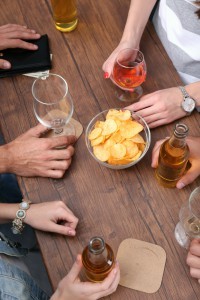
If you’re planning to have a booze it up, think before you drink! Get to know how alcohol affects your blood sugars if you are living with diabetes. Much misinformation exists about whether or not people with diabetes should knock back a beer, but the truth is that sipping on a little gin and juice in moderation is okay. It may even have some health benefits. Even so, when drinking with diabetes there are certain steps you should keep in mind to avoid a hypo at the pub.
The general guidelines for alcohol consumption are one drink per day for the ladies and two drinks for the gents (a drink is defined as 12oz for beer, 5oz for wine, and 1.5oz for distilled spirits like whisky and vodka). This guideline is the same for people with or without diabetes.[1] Before you decide to consume alcohol, you should always consult first with your diabetes healthcare team. Certain medications or diabetes complications you are experiencing may not make it a good idea to drink alcoholic beverages.
One of the biggest risks to consider if you plan to drink alcohol is that it increases the chances for experiencing hypoglycemia. Alcohol can put added pressure on the liver. Your body views alcohol as a toxin and your liver works hard to get clean it from your system. Your liver is also working hard to help regulate your blood sugar, so when you drink you are essentially putting it to work a double shift. It can also become difficult to distinguish between the signs of hypoglycemia and being tipsy since the symptoms are similar, like feeling sluggish or dizzy.[2] Let your drinking buddies know that you have diabetes and what they should look out for or do if you need some help.
- Make sure you don’t liquor up on an empty stomach or if your blood sugar is too low. Eat as you would normally and don’t replace your meals with a liquid lunch. Carry snacks with you just in case you need to treat your hypo.
- Check your blood sugar before, during, and after you drink. Don’t forget to check before bedtime too. If you are having a hypo, your Dario app can alert your family members or friends that you need some help. Adjust your insulin if needed and as discussed with your doctor.
- Beware of sugary mixers that can be added to your drinks.
- Wear a medical alert ID or flash your diabetic tattoo somewhere if you have one.
- Don’t drink and drive!
- Don’t chug-a-lug; sip-and-savor! Make that drink last longer and drink a couple glasses of water or no calories beverages in between.[3]
- If you’re also out on the dance floor, don’t forget that exercise (and sex) can also lower your blood glucose levels.[4]
Being in social situations where alcohol is a focal point can be difficult in a society that indulges in everything but moderation. And remember it always your choice whether or not you want to drink – you don’t have to give into peer pressure. Plus you could be a great help to friends if you can be the designated driver for a night out on the town!
[1] American Diabetes Association. (2014). Alcohol.
[2] Healthination (2015). Video: Alcohol and Diabetes.
[3] Diabetes UK. Alcohol – Drinking and Diabetes.
[4] MacNaught, N. & Holt, P. (2015) Type 1 diabetes and alcohol consumption Nursing Standard. 29, 50, p. 41-47.







